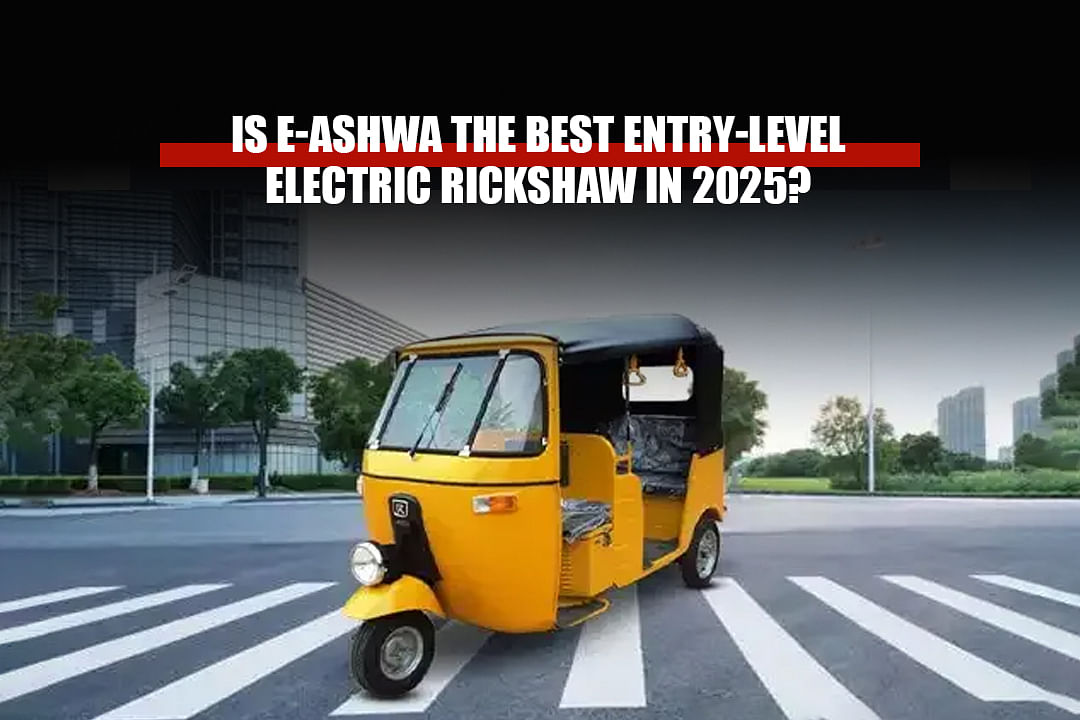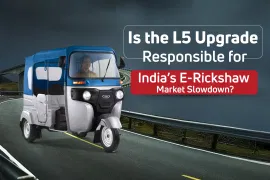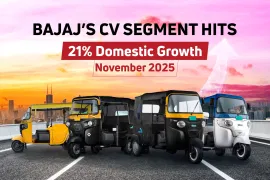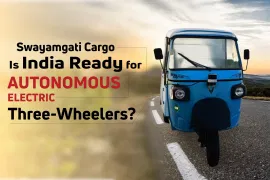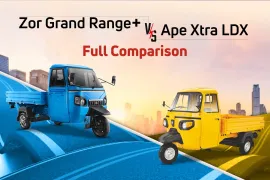India's electric vehicle industry is transforming rapidly, in 2025, efficient and economical transport has become the new direction. Entry-level electric rickshaws now fuel commercial mobility growth, among them, E-Ashwa Electric Rickshaw has carved a niche for itself, but is it the best in the segment? To determine that, we must analyze its design, features, cost, and real-world performance.
E-Ashwa 2025: Core Specifications
This electric rickshaw delivers essential features for daily operations. Its specifications are designed for cost-effectiveness and operational ease:
| Specification | Details |
| Motor Power | 900W High power |
| Battery Type | Lead Acid (48V-155AH) Lead acid |
| Range Per Charge | 80–100 km (Li-ion), 60–70 km (Lead Acid) |
| Charging Time | 3–4 hrs (Li-ion), 5–6 hrs (Lead Acid) |
| Top Speed | 25 km/h |
| Passenger Capacity | Driver + 4 passengers |
| Weight (Kerb) | Approx. 290–310 kg |
| Tyres | 3.75-12 Tubeless |
| Additional Features | Analogue display, Parking Brakes |
| Warranty | 1 Year (Battery and Motor) |
| Starting Price | ₹1.40 lakh – ₹1.90 lakh (Ex-Showroom) |
The layout supports daily routes, especially in urban, semi-urban, and rural areas. The top speed and range are well-aligned with the demands of short-distance commercial travel.

Why E-Ashwa Is Unique in 2025
E-Ashwa triumphs as it addresses basic business requirements. The company knows its target audience, initial owners, single drivers, and small shopkeepers. This rickshaw is best for the segment because:
1. Low Investment, High Utility
Its initial price for purchase begins at ₹1.30 lakh, making it a convenient vehicle for new operators. Return on investment is fast, particularly for drivers undertaking 8–10 trips daily. The cost of running is low because of easy-to-replace parts and an electric drivetrain.
2. Range That Meets Daily Requirements
The lithium-ion version offers up to 100 km per charge, that covers a full workday for most last-mile routes. Even the lead-acid version, with 60–70 km range, works for shorter, repetitive circuits. Charging completes overnight, ensuring readiness each morning.
3. Reliable Structure for Tough Roads
E-Ashwa is not over-engineered, it has a balanced weight and strength design. With a metal chassis, basic suspension, and strengthened cabin base, it traverses potholes and rough roads. The vehicle resists corrosion and has fewer replacements in the long run.
4. Easy Maintenance, Wide Compatibility
Maintenance is easy, most problems can be solved at local garages. Parts are easy to source and do not need digital diagnostics. This makes the vehicle perfect for areas where there are no EV servicing centers.
E-Ashwa vs. Other Entry-Level Models
There are various models competing in the same segment. Mahindra Treo, Piaggio Ape E-City, and Kinetic Safar Smart are alternatives. However, E-Ashwa retains its position with price advantage and usability.
Mahindra Treo has additional power and speed but requires additional investment, ₹2 lakh and above. It is ideal for organized fleet operations. Piaggio aims at metro routes but takes advantage of a charging network rural India still does not have. Kinetic and Saarthi are priced similarly to E-Ashwa but do not have the same post-sales support.
E-Ashwa wins on account of having real-world usage support frequent stops, short routes, limited downtime, and technologically restricted users.
Who Should Buy E-Ashwa in 2025?
This rickshaw is best for:
- New drivers beginning local passenger service
- Vendors requiring a goods carrier at budget
- Fleets growing electric but managing capital expenses
- Entrepreneurs in Tier 2 and Tier 3 cities with limited charging infrastructure
Due to its small construction and accessible components, E-Ashwa is suitable for business models that rely on uptime and cost management.
What Should You Keep in Mind?
No vehicle lacks trade-offs. E-Ashwa has some:
- The top speed, limited to 25–30 km/h, inhibits highway use.
- There are no sophisticated digital features such as telematics.
- Its brand image, while enhancing, isn't quite as powerful in metro fleets.
Even so, these deficiencies are secondary if your primary objective is low-cost, entry-level transport with established performance.
Frequently Asked Questions (FAQ)
Q1. What is the 2025 on-road price?
In addition to insurance, RTO, and state-level subsidies, the price varies between ₹1.50 lakh and ₹1.85 lakh.
Q2. Is E-Ashwa eligible for subsidies?
Yes. Lithium-ion variants are usually eligible under the FAME-II subsidy and other state incentives.
Q3. How long does the battery last?
Lead-acid batteries have a life of around 12–18 months. Lithium-ion variants will go 3–4 years when charged well.
Q4. Will it easily get repaired in local markets?
Yes. Basic EV-trained mechanics can address routine problems. E-Ashwa spares are commonly available in most markets.
Q5. Is there a cargo variant?
Yes. E-Ashwa offers both passenger and cargo variants, suitable for delivery services and vendor logistics.
Final Conclusion
E-Ashwa Electric Rickshaw, in its 2025 version, is not a technological wonder. It does not claim more than it can deliver. What it offers is a serviceable, inexpensive, and reliable electric vehicle for commercial use in the real world. For drivers in small towns, for vendors who have a daily cycle of deliveries, or for entrepreneurs growing gradually, this rickshaw is the right building block.
It does not have the bling of city models or the software amenities of more substantial OEMs, but E-Ashwa is delivering value. And in the entry-level electric rickshaw segment, value is what makes it go.
For more articles and news, stay updated with 91trucks. Subscribe to our YouTube channel and follow us on Facebook, Instagram, and LinkedIn for the latest videos and updates from the automotive world!
Read More:
Web Stories
Latest Three Wheelers News
Categories
91trucks is a rapidly growing digital platform that offers the latest updates and comprehensive information about the commercial vehicle industry.
